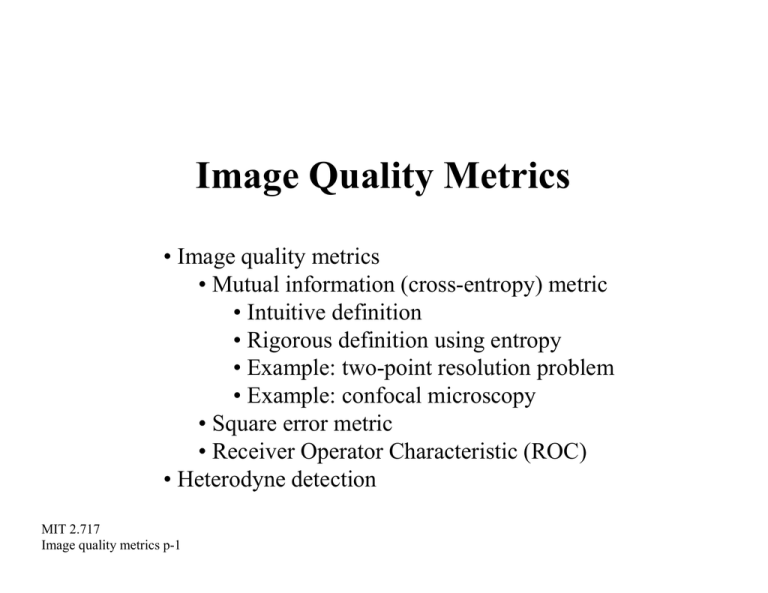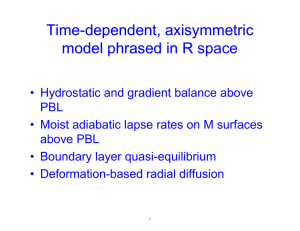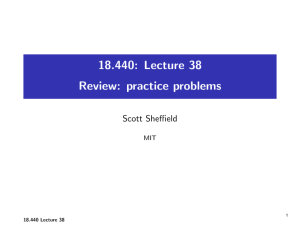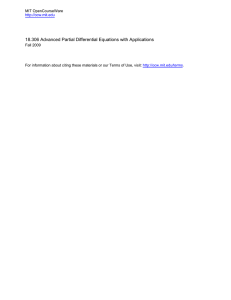Document 13612184
advertisement

Image Quality Metrics • Image quality metrics • Mutual information (cross-entropy) metric • Intuitive definition • Rigorous definition using entropy • Example: two-point resolution problem • Example: confocal microscopy • Square error metric • Receiver Operator Characteristic (ROC) • Heterodyne detection MIT 2.717 Image quality metrics p-1 Linear inversion model object “physical attributes” (measurement) hardware channel field propagation f H detection inversion problem: determine f, given the measurement g g =H f (noise variance) σ2 noise-to-signal ratio (NSR) = = =σ 2 (average signal power) 1 normalizing signal power to 1 MIT 2.717 Image quality metrics p-2 Mutual information (cross-entropy) object “physical attributes” (measurement) hardware channel field propagation f H 2 µ k 1 C = ∑ ln1 + 2 2 k =1 σ n MIT 2.717 Image quality metrics p-3 detection g eigenvalues of H The significance of eigenvalues rank of measurement (aka how many dimensions the measurement is worth) 1 n µ k2 C = ∑ ln1 + 2 2 k =1 σ n ... n-1 1 0 σ2 µ n2 2 µ n−1 ... eigenvalues of H MIT 2.717 Image quality metrics p-4 µ 22 µ1 2 Precision of measurement 1 n µ k2 C = ∑ ln1 + 2 = 2 k =1 σ µ t2 < σ 2 < µ t2−1 noise floor µ t2− 2 µ t2−1 µ t2 ... + ln 1 + 2 + ln 1 + 2 + ln1 + 2 + ... σ σ σ ≈precision of (t-2)th measurement this term ≤1 E.g. 0.5470839348 these digits worthless if σ ≈10-5 MIT 2.717 Image quality metrics p-5 this term ≈0 Formal definition of cross-entropy (1) Entropy in thermodynamics (discrete systems): • log2[how many are the possible states of the system?] E.g. two-state system: fair coin, outcome=heads (H) or tails (T) Entropy=log22=1 Unfair coin: seems more reasonable to “weigh” the two states according to their frequencies of occurence (i.e., probabilities) Entropy = − ∑ p(state ) log 2 p(state ) states MIT 2.717 Image quality metrics p-6 Formal definition of cross-entropy (2) • Fair coin: p(H)=1/2; p(T)=1/2 1 1 1 1 Entropy = − log 2 − log 2 = 1 bit 2 2 2 2 • Unfair coin: p(H)=1/4; p(T)=3/4 3 1 3 1 Entropy = − log 2 − log 2 = 0.81 bits 4 4 4 4 Maximum entropy ⇔ Maximum uncertainty uncertainty MIT 2.717 Image quality metrics p-7 Formal definition of cross-entropy (3) Joint Entropy Entropy log2[how many are the possible states of a combined variable obtained from the Cartesian product of two variables?] Joint Entropy( X , Y ) = − ∑ ∑ p(x, y )log p(x, y ) 2 states states x∈ X y∈Y E.g. Joint Entropy(F , G ) = ? object “physical attributes” (measurement) hardware channel f MIT 2.717 Image quality metrics p-8 field propagation H detection g Formal definition of cross-entropy (4) Conditional Entropy Entropy log2[how many are the possible states of a combined variable given the actual state of one of the two variables?] Cond. Entropy(Y | X ) = − ∑ ∑ p(x, y )log p( y | x ) 2 states states x∈X y∈Y E.g. Cond. Entropy(G | F ) = ? object “physical attributes” (measurement) hardware channel f MIT 2.717 Image quality metrics p-9 field propagation H detection g Formal definition of cross-entropy (5) object “physical attributes” (measurement) hardware channel f field propagation H detection g Noise adds uncertainty to the measurement wrt the object ⇔ eliminates information from the measurement wrt object MIT 2.717 Image quality metrics p-10 Formal definition of cross-entropy (6) uncertainty added due to noise Cond. Entropy(F | G ) representation by Seth Lloyd, 2.100 Entropy(F ) C(F , G ) information contained in the object Cond. Entropy(G | F ) information eliminated due to noise MIT 2.717 Image quality metrics p-11 Entropy(G ) information contained in the measurement cross-entropy (aka mutual information) Formal definition of cross-entropy (7) Joint Entropy(F , G ) Cond. Entropy(F | G ) Entropy(F ) MIT 2.717 Image quality metrics p-12 C(F , G ) Cond. Entropy(G | F ) Entropy(G ) Formal definition of cross-entropy (8) F information source (object) Physical Channel (transform) Corruption source (Noise) G information receiver (measurement) C( F , G ) = Entropy(F ) − Cond. Entropy( F | G ) = Entropy(G ) − Cond. Entropy(G | F ) = Entropy(F ) + Entropy(G ) − Joint Entropy( F , G ) MIT 2.717 Image quality metrics p-13 Entropy & Differential Entropy • Discrete objects (can take values among a discrete set of states) – definition of entropy Entropy = −∑ p( xk ) log 2 p ( xk ) k – unit: 1 bit (=entropy value of a YES/NO question with 50% uncertainty) • Continuous objects (can take values from among a continuum) – definition of differential entropy Diff. Entropy = − ∫( p) (x )ln p (x ) dx Ω X – unit: 1 nat (=diff. entropy value of a significant digit in the representation of a random number, divided by ln10) MIT 2.717 Image quality metrics p-14 Image Mutual Information (IMI) object “physical attributes” (measurement) hardware channel f Assumptions: Then MIT 2.717 Image quality metrics p-15 field propagation H detection g (a) F has Gaussian statistics (b) white additive Gaussian noise (waGn) i.e. g=Hf+w where W is a Gaussian random vector with diagonal correlation matrix 1 n µ k2 C ( F , G ) = ∑ ln1 + 2 2 k =1 σ µ k : eigenvalues of H Mutual information & degrees of freedom rank of measurement n ... n-1 1 0 σ2 µ n2 mutual information µ n2−1 1 n µ k2 C = ∑ ln1 + 2 2 k =1 σ ... µ 22 µ12 As noise increases • one rank of H is lost whenever σ2 overcomes a new eigenvalue • the remaining ranks lose precision σ2 MIT 2.717 Image quality metrics p-16 Example: two-point resolution Finite-NA imaging system, unit magnification Two point-sources (object) fA fB Two point-detectors (measurement) A x B ~ A gA ~ B gB Classical view intensities emitted noiseless intensity @detector plane g A gB MIT 2.717 Image quality metrics p-17 x intensities measured Cross-leaking power g A = f A + sf B g B = sf A + f B s = sinc ( x ) 2 s ~ A MIT 2.717 Image quality metrics p-18 ~ B IMI for two-point resolution problem 1 s H = s 1 det (H ) = 1 − s 2 µ 1 = 1 + s µ2 = 1− s 1 1 − s H = 2 1− s − s 1 −1 1 (1 − s ) C(F , G ) = ln1 + 2 σ2 2 MIT 2.717 Image quality metrics p-19 1 (1 + s )2 + ln1 + 2 2 σ IMI vs source separation (SNR ) = MIT 2.717 Image quality metrics p-20 s→1 1 σ2 s→0 IMI for rectangular matrices (1) H = = H underdetermined (more unknowns than measurements) overdetermined (more measurements than unknowns) eigenvalues cannot be computed, but instead we compute the singular values of the rectangular matrix MIT 2.717 Image quality metrics p-21 IMI for rectangular matrices (2) HT = square matrix H ( fˆ = H T H recall pseudo-inverse ) −1 HT g inversion operation associated with rank of ( ) eigenvalues H T H ≡ singular values(H ) MIT 2.717 Image quality metrics p-22 IMI for rectangular matrices (3) object “physical attributes” (measurement) hardware channel field propagation f H detection g under/over determined 1 n τ k C = ∑ ln1 + 2 2 k =1 σ MIT 2.717 Image quality metrics p-23 singular values of H Confocal microscope Small pinhole: Depth resolution pinhole virtual slice Light efficiency object beam splitter Intensity detector Large pinhole: Depth resolution Light efficiency MIT 2.717 Image quality metrics p-24 Depth “resolution” vs. noise Object structure: point sources, mutually incoherent optical axis sampling distance Imaging method correspondence intensity measurements CFM object scanning direction MIT 2.717 Image quality metrics p-25 NA=0.2 Depth “resolution” vs. noise & pinhole size MIT 2.717 Image quality metrics p-26 units: Rayleigh distance IMI summary • It quantifies the number of possible states of the object that the imaging system can successfully discern; this includes – the rank of the system, i.e. the number of object dimensions that the system can map – the precision available at each rank, i.e. how many significant digits can be reliably measured at each available dimension • An alternative interpretation of IMI is the game of “20 questions:” how many questions about the object can be answered reliably based on the image information? • IMI is intricately linked to image exploitation for applications, e.g. medical diagnosis, target detection & identification, etc. • Unfortunately, it can be computed in closed form only for additive Gaussian statistics of both object and image; other more realistic models are usually intractable MIT 2.717 Image quality metrics p-27 Other image quality metrics •• Mean Square Error (MSQ) between object and image ( E = ∑ f k − fˆk object samples ) 2 result of ˆf = k inversion – e.g. pseudoinverse minimizes MSQ in an overdetermined problem – obvious problem: most of the time, we don’t know what f is! – more when we deal with Wiener filters and regularization •• Receiver Operator Characteristic – measures the performance of a cognitive system (human or computer program) in a detection or estimation task based on the image data MIT 2.717 Image quality metrics p-28 Receiver Operator Characteristic Target detection task Example: medical diagnosis, • H0 (null hypothesis) = no tumor • H1 = tumor TP = true positive (i.e. correct identification of tumor) FP = false positive (aka false alarm) MIT 2.717 Image quality metrics p-29






